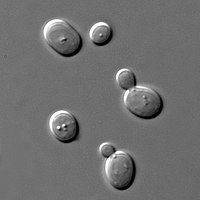
Photo from wikipedia
Flat peaches possess characteristic flavors and are rich in nutrients. The fermentation of flat peaches to produce wine through complex biochemical reactions is an effective method to overcome their seasonal… Click to show full abstract
Flat peaches possess characteristic flavors and are rich in nutrients. The fermentation of flat peaches to produce wine through complex biochemical reactions is an effective method to overcome their seasonal defects. Spontaneously fermented flat peach wine has plentiful and strong flavors, but the microbiota of fermentation are still unknown. In this study, the microbial succession and volatile compound dynamics of spontaneous fermentation in Xinjiang flat peach wine were investigated using high-throughput sequencing (HTS) and headspace solid phase microextraction (HS-SPME) coupled with gas chromatography-mass spectrometry (GC-MS) technology, respectively, to better understand the microbiota involved. Multivariate data analysis was used to predict the relationship between microorganisms and volatile chemicals. The results showed that Kazachstania, Pichia, Aspergillus, Fructobacillus, Leuconostoc, and Lactobacillus were the dominant genera during the spontaneous fermentation of flat peach wine. Furthermore, ethyl hexanoate, 3-hexen-1-yl acetate, ethyl caprate, ethyl caprylate, phenethyl acetate, ethanol, γ-decalactone, decanal, 1-hexanoic acid, and octanoic acid endued flat peach wine with a strong fruity and fatty aroma. The core functional microbiota (primarily consisting of 11 bacterial and 14 fungal taxa) was strongly associated with the production of 27 volatile compounds in the spontaneously fermented flat peach wine, according to multivariate data analysis. Some alcohols and esters were positively linked with the presence of Kazachstania and Pichia. Meanwhile, the presence of Fructobacillus, Leuconostoc, Lactobacillus, and Weissella was significantly correlated with 2-non-anol, ethanol, 3-methyl-1-butanol, octyl formate, isoamyl lactate, and ethyl lactate. This snapshot of microbial succession and volatile compound dynamics provides insights into the microorganisms involved in flat peach wine fermentation and could guide the production of flat peach wine with desirable characteristics.
Journal Title: Frontiers in Microbiology
Year Published: 2022
Link to full text (if available)
Share on Social Media: Sign Up to like & get
recommendations!